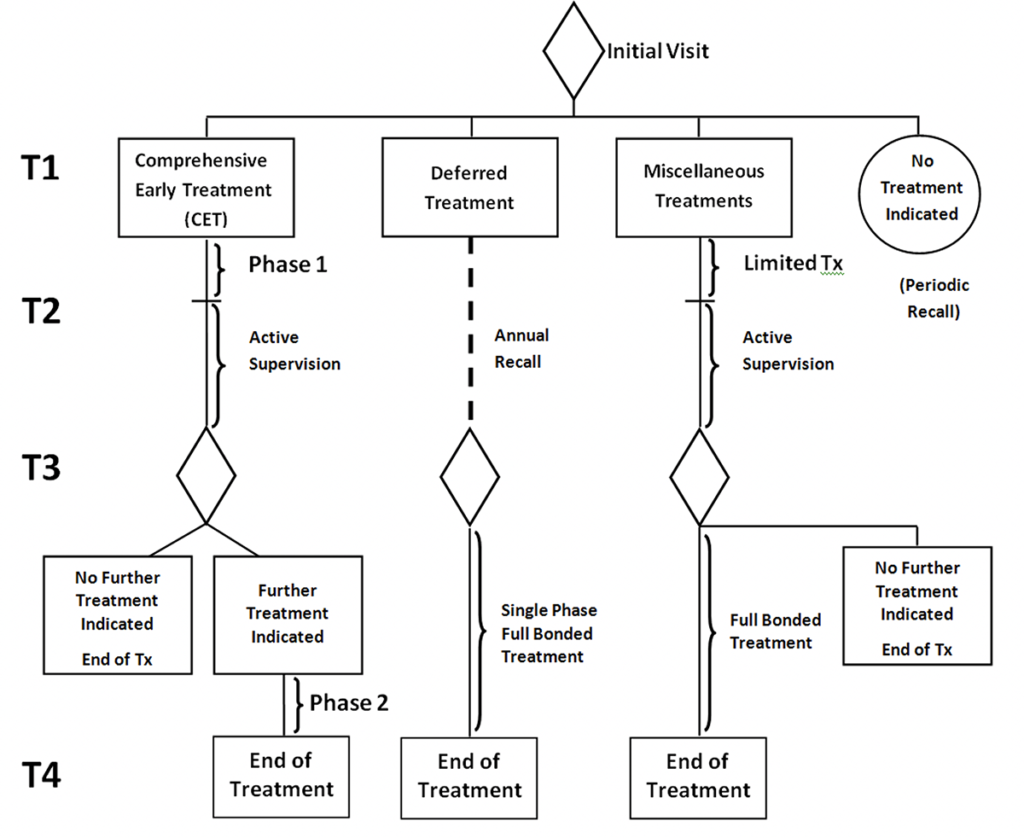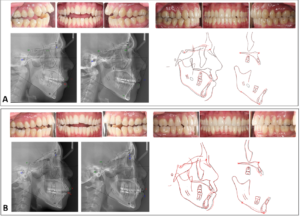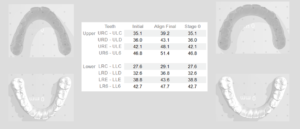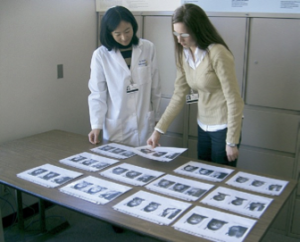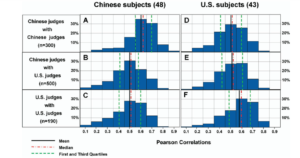Orthodontic Outcome Studies
1. Mixed Dentition Treatment Study
We have systematically collected random samples from the records of patients who presented in the early mixed dentition stage in the practices of three members of the clinical orthodontic faculty at our school. The study is aimed at measuring the usual course and outcome of treatment when experienced clinicians familiar with both mixed dentition treatment and treatment early in permanent dentition use the therapeutic modality that they consider best for each patient.
Background of the Mixed Dentition Controversy in Orthodontics
Orthodontists have long debated the relative merits of starting treatment in the mixed dentition (from approximately 7 to 9 years of age) versus postponing intervention until the eruption of the permanent dentition at 11 or 12. The desirability of early intervention to redirect the pattern of tooth eruption as soon as the development of a malocclusion is observed seems attractive on its face. If corrective therapy is instituted early in the development of an anomalous occlusal relationship, normal occlusion can usually be restored quite readily. However we do not yet have the ability to predict the precise course of subsequent growth with accuracy for individual subjects. For this reason, when the restoration of normal occlusion is achieved by treatment of still-growing subjects, some of the gains of intervention can be lost during the remaining period of growth.
Hence, two distinct schools of thought have developed among orthodontists —the early and later interventionists alluded to above. The main argument in favor of early intervention has been that it offers the possibility of mitigating the severity of the developing malocclusion and restoring optimal conditions for the eruption of the bicuspids and canines into relatively normal alignment, somewhat on the theory that “as the twig is bent, so the tree inclines.” The main argument in favor of postponing intervention until the eruption of the full complement of permanent teeth is that when malocclusions are corrected early, residual growth may be sufficient to cause recurrence of at least a partial mal-relationship in some subjects.
H Oh, S Baumrind, S Dugoni, R Boero, M Aubert, R Boyd. A retrospective study of Class II mixed-dentition treatment. Angle Orthodontist 2017; 87:56-67.
H Oh, N Ma, P Feng, K Kieu, R Boero, S Dugoni, M Aubert, D Chambers. Evaluation of Post-treatment stability following orthodontic treatment in the mixed and permanent dentitions. Angle Orthodontists 2016; 86:1010-1018.
2. Clear Aligner Study
A. Openbite Study
Since its by Align Technology (Santa Clara, Calif) in 1999, the clear aligner system has become a popular treatment choice for adult patients; this is largely due to the superior aesthetics and comfort that removable clear aligners provide over traditional full bonded fixed appliances. Earlier studies showed the significant limitations of Invisalign® treatment in treating complex malocclusions.
We investigated the effectiveness of clear aligners in controlling the vertical dimension and in correcting anterior open bites by comparing the outcomes of clear aligner therapy to that of fixed appliance therapy in adult patients with hyper-divergent skeletal patterns (mandibular plane angles ≥38°).
B. Invisalign First Study
Invisalign First is the newest development by Align Technology for children who need Phase 1 orthodontic treatment. The study examines the efficacy, predictability, and efficiency of clear aligner therapy in the mixed dentition.

3. Facial Attractiveness Study
Facial esthetics plays a more important role in the reason people seek orthodontic treatment. We investigated the perception of the “facial attractiveness” of orthodontic patients by orthodontists both before and after treatment. It is a series of a cross cultural study on “facial attractiveness” involving the ranking of end-of-treatment photos of 90 orthodontic patients by 45 Chinese and U.S orthodontists.
The first study assessed agreement and disagreement among pairs of Chinese and U.S orthodontists in the ranking for “facial attractiveness” of end-of-treatment photographs of growing Chinese and white orthodontic patients. These findings appear consistent with the inference that, on average, judgments of “facial attractiveness” by orthodontists at the 2 venues are more similar than had been expected for patients of Chinese and white ethnicity.
The second part of the study was to determine the cephalometric bases for the subjective judgments of facial attractiveness. It also examined the extent to which specific cephalometric variables can predict facial attractiveness from ranking data from end of treatment facial photographs.
In general, correlations between cephalometric variables and rankings of facial attractiveness were less strong than had been expected. Soft tissue cephalometric measures performed slightly better than hard tissue measures but no cephalometric measure accounted for more than 1/3 of the variance in the photographic rankings.
2009 HS Oh, EL Korn, XY Zhang, Y Liu, T-M Xu, R Boyd, S Baumrind: Correlation between cephalometric and photographic measurements of facial attractiveness in Chinese and U.S. patients at the end of orthodontic treatment. American Journal of Orthodontics & Dentofacial Orthopedics, 2009;136:762.e1-762.e14.
2009 Y Liu, EL Korn, HS Oh, H Pearson, T-M Xu, S Baumrind: Comparison of Chinese and U.S. Orthodontists’ Averaged Evaluations of “Facial Attractiveness” from End-of-Treatment Facial Photographs. American Journal of Orthodontics & Dentofacial Orthopedics 2009;135:621-34.
2008 T-M Xu, EL Korn, Y Liu, HS Oh, KH Lee, S Baumrind: “Facial Attractiveness”: Ranking of End-of-Treatment Facial Photographs by Chinese and U.S. Orthodontists. American Journal of Orthodontics & Dentofacial Orthopedics 2008;134:74-84.

